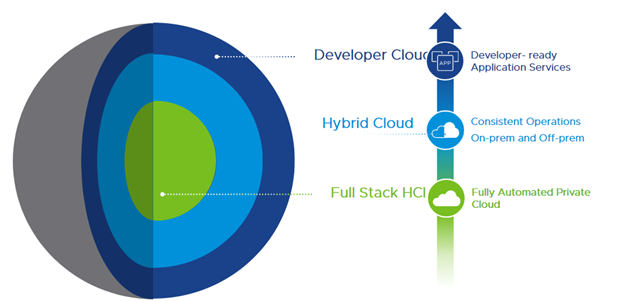Three quarters of IT leaders believe their organizations’ digital transformation was accelerated by COVID-19, according to a recent MIT Technology Review study. And investment continues. Plans are heavily focused on deploying applications and services at scale—strategies that require cloud innovation.
IDC estimates enterprises will build 500 million new apps using cloud native technologies by 2023. But cloud is not enough. As applications get more complex, diverse and heterogenous application needs ultimately drive infrastructure strategies. IT teams need a more flexible, agile approach to meeting business demands. And that starts with consistency when spinning up new capabilities—across all environments. Hyperconverged infrastructure (HCI) can easily deliver this uniformity.
HCI is a software-defined model that combines the elements of a traditional data center—storage, compute, network and management. HCI boosts agility and optionality without the expensive, purpose-built hardware associated with data center infrastructure. It also combines integrated software and x86 servers to:
- Reduce infrastructure complexity.
- Increase scalability.
- Establish intrinsic security that permeates the entire system.
Why HCI?
Analysts at 451 Research identified four main reasons organizations adopt HCI:
- Simplify infrastructure management.
- Accelerate provisioning.
- Support a hybrid cloud strategy.
- Support emerging technologies, namely containers.
Initially, organizations chose HCI to simplify infrastructure and accelerate provisioning. Now, they view HCI as a hybrid cloud foundation to effectively extend operations to data centers beyond their own. They’re also interested in leveraging container technology to deploy applications quickly and easily across multiple environments, assisted and automated through orchestration platforms like Kubernetes. This calls for a more complete approach to HCI.
The Need for Full-Stack HCI
“Today, customers are focused on full-stack HCI,” said John Gilmartin, senior vice president and general manager of the VMware Cloud Platform Business Unit during VMworld 2020.
Gilmartin characterized full-stack HCI as the new starting point for a complete, automated private cloud infrastructure. “And customers are using that private cloud as a jumping off point to extend out to the hybrid cloud,” he said.
To pivot fast, organizations are thinking about delivering developer-ready application services on top of a hybrid cloud infrastructure. This would make it easier for developers to consume developer-centric services and collaborate with operational teams. VMware’s Tanzu portfolio, for example, provides that capability, modernizing application delivery over a hyperconverged infrastructure.
An HCI-based cloud platform positions IT teams to automate and orchestrate infrastructure elements, making systems easier to architect and deploy. Once they’ve done so, the cloud platform allows organizations to use the same on-premises system to manage its entire cloud ecosystem, from the edge to the public cloud.
“It really comes down to developing that cloud operating model,” Gilmartin said, “and focusing more time and energy servicing the needs of application teams and helping them be productive and successful.”
HCI In the Real World
T-Systems International GmbH, headquartered in Germany, helps clients with digital transformations, managing companies’ journey to the cloud. At VMworld 2020, Thomas Rumpf, T-Systems’ Chief Technology Officer for private cloud, said that virtually all the company’s clients were using one of more public clouds. But most workloads ran on-premises or via a hosted platform.
“We were looking for a solution that let us serve these clients on-premises or in a T-Systems data center, but also in the cloud,” Rumpf said. “A platform that let us run traditional applications next to cloud-native, containerized applications on the same platform.”
Rumpf said T-Systems also wanted a solution for quickly rolling out infrastructure, so it could be more agile and scale up and down more easily. The company adopted VMware’s solution and rolled it out in April to positive customer feedback.
“T-Systems’ VMware Cloud Foundation-based platform provides clients with a consistent infrastructure and a consistent operating model that lets them move into the cloud at their own pace,” Rumpf told attendees. “They can use their existing tools and processes and manage their workloads, whether hosted on T-Systems’ platform or on VMware Cloud on AWS. With the help of AWS, we are able to provide a private cloud experience that truly looks and feels like a public cloud.”
One T-Systems customer said they deployed a distributed application in less than three hours—a process that previously took five days.

Next Steps
HCI serves as the ideal solution for everything from data persistence to enabling disaster recovery in the cloud. Here’s how organizations get started:
- Evolve to the private cloud by deploying full-stack HCI in the data center. This will make developers more productive and reduce the amount of time spent managing infrastructure.
- Extend to the hybrid cloud using a consistent operating model across private and public clouds. This will allow organizations to move workloads and perform disaster recovery consistently without re-platforming applications.
- Ensure developer readiness with a set of consistent services on top of the hybrid cloud. This will help developers consume infrastructure the way they need to—quickly and easily.
“When we talk about what's driving all this thinking about infrastructure strategy, it's all about applications,” Gilmartin said. “The needs of developers and application owners are driving infrastructure strategy.” And the future-ready path forward is hyperconverged infrastructure.

